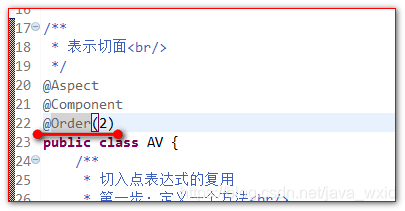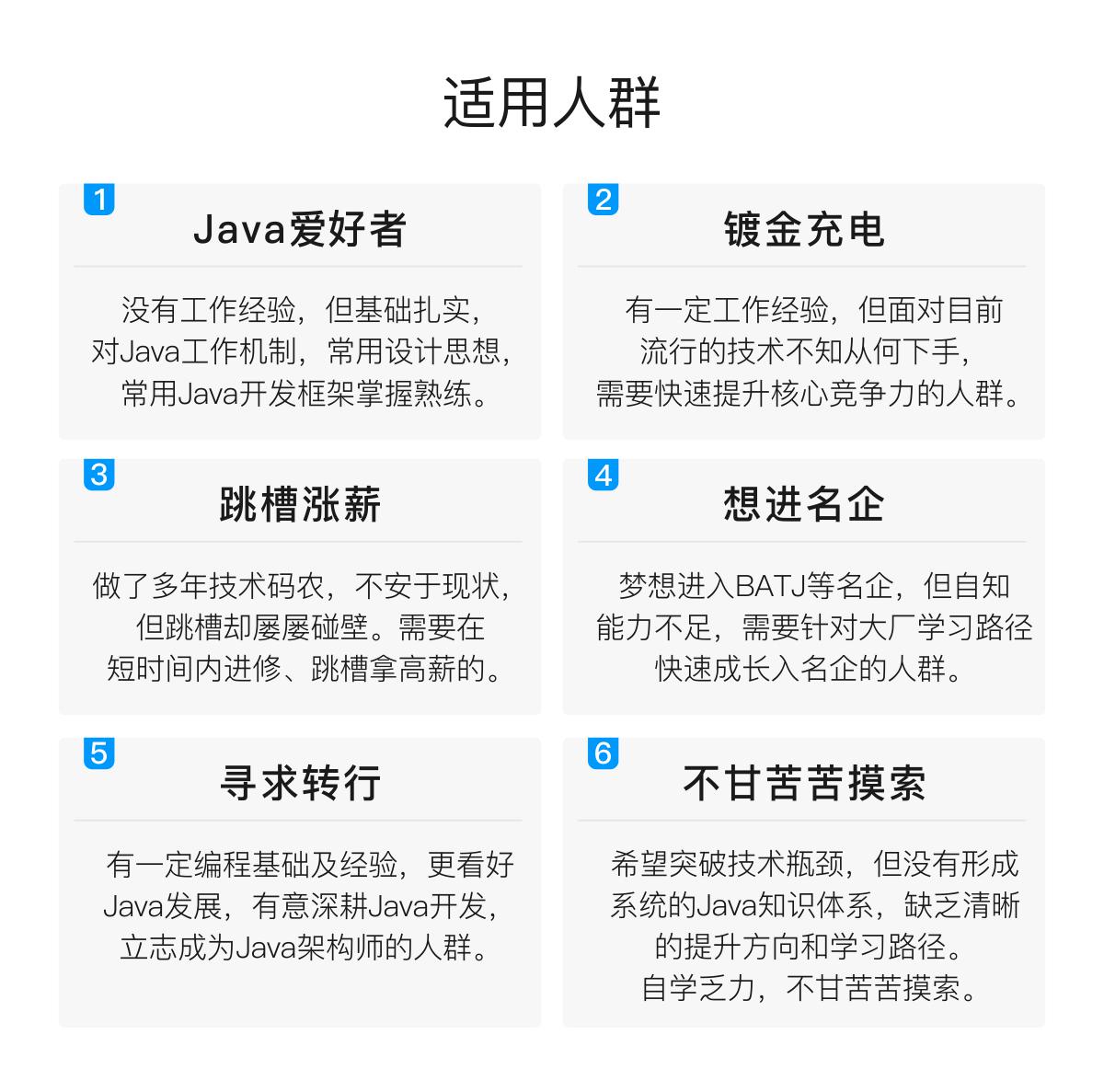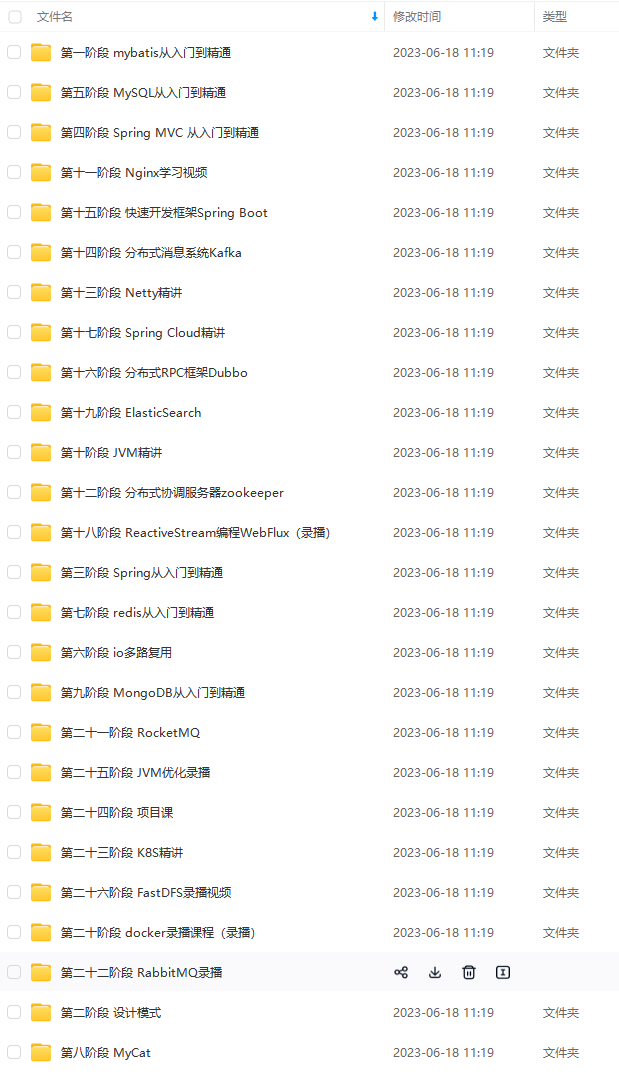Spring的切入点表达式
@PointCut切入点表达式语法格式是:
execution(访问权限 返回值类型 方法全限定名(参数类型列表))
execution(public int com.atguigu.pojo.Calculator.add(Integer, Integer))
限定符:
_表示任意的意思:
1)匹配某全类名下,任意或多个方法。
execution(public int com.atguigu.pojo.Calculator._(Integer, Integer))
表示匹配任意的方法
2)在Spring中只有public权限能拦截到,访问权限可以省略(访问权限不能写*)。
execution(int com.atguigu.pojo.Calculator.*(Integer, Integer))
可以省略public访问权限
3)匹配任意类型的返回值,可以使用 * 表示
execution(public * com.atguigu.pojo.Calculator.*(Integer, Integer))
表示可以接受任意返回值类型
4)匹配任意子包。
execution(public int com.atguigu.*.Calculator.add(Integer, Integer))
匹配任意子包
5)任意类型参数
execution(public int com.atguigu.pojo.Calculator.add(Integer, *))
表示第二个参数是任意类型的参数
…:可以匹配多层路径,或任意多个任意类型参数
1)任意层级的包
execution(public int com…pojo.Calculator.add(Integer, Integer))
表示com和pojo之间可以有任意层级的包。
2)任意类型的参数
execution(public int com.atguigu.pojo.Calculator.add(…))
不关心参数的个数,和参数的类型。
模糊匹配:
// 表示任意返回值,任意方法全限定符,任意参数
execution(* _(…))
// 表示任意返回值,任意包名+任意方法名,任意参数
execution(_ .(…))
精确匹配:
execution(public int com.atguigu.aop.Calculator.add(int, int))
切入点表达式连接:&& 、||
// 表示需要同时满足两个表达式
@Before(“execution(public int com.atguigu.aop.Calculator.add(int, int))”
+ " && "
- “execution(public * com.atguigu.aop.Calculator.add(…))”)
// 表示两个条件只需要满足一个,就会被匹配到
@Before(“execution(public int com.atguigu.aop.Calculator.add(int, int))”
+ " || "
+ “execution(public * com.atguigu.aop.Calculator.a*(int))”)
9.9、Spring通知的执行顺序
Spring通知的执行顺序是:
正常情况:
前置通知====>>>>目标方法====>>>>后置通知=====>>>>返回值之后
异常情况:
前置通知====>>>>目标方法====>>>>后置通知=====>>>>抛异常通知
@Aspect
@Component
public class LogUtils {
/**
* @Before是前置通知
_/
@Before(value = “execution(public int com.atguigu.pojo.Calculator._(Integer, Integer))”)
// 前置通知===前置增强
public static void logBefore() {
System.out.println(“前置通知 : 方法名:xxxx. 参数是:args”);
}
/**
* @After 后置通知
_/
@After(value = “execution(public int com.atguigu.pojo.Calculator._(Integer, Integer))”)
public static void logAfter() {
System.out.println(“后置通知: 方法名:. 参数是:”);
}
/**
* 返回值通知
_/
@AfterReturning(value = “execution(public int com.atguigu.pojo.Calculator._(Integer, Integer))”)
public static void logAfterReturning() {
System.out.println(“返回通知: 方法名:. 返回值是:”);
}
/**
* 异常通知
_/
@AfterThrowing(value = “execution(public int com.atguigu.pojo.Calculator._(Integer, Integer))”)
public static void logAfterThrowing() {
System.out.println(“异常通知: 方法名:. 异常信息是:”);
}
}
获取连接点信息
JoinPoint 是连接点的信息。
只需要在通知方法的参数中,加入一个JoinPoint参数。就可以获取到拦截方法的信息。
注意:是org.aspectj.lang.JoinPoint这个类。
/**
- @Before是前置通知
*/
@Before(value = “execution(public int com.atguigu.pojo.Calculator.*(Integer, Integer))”)
// 前置通知===前置增强
public static void logBefore(JoinPoint jp) {
// jp.getSignature().getName() 获取方法名
// jp.getArgs() 获取目标方法传递的参数
System.out.println(“前置通知 : 方法名:” + jp.getSignature().getName() + “. 参数是:” + Arrays.asList(jp.getArgs()));
}
获取拦截方法的返回值和抛的异常信息
获取方法返回的值分为两个步骤:
1、在返回值通知的方法中,追加一个参数 Object result
2、然后在@AfterReturning注解中添加参数returning=“参数名”
/**
-
返回值通知
-
returning属性设置用哪个参数来接收返回值
*/
@AfterReturning(value = “execution(public int com.atguigu.pojo.Calculator.*(Integer, Integer))”,returning=“result”)
public static void logAfterReturning(JoinPoint jp, Object result) {
System.out.println(“返回通知: 方法名:” + jp.getSignature().getName() + “. 返回值是:” + result);
}
获取方法抛出的异常分为两个步骤:
1、在异常通知的方法中,追加一个参数Exception exception
2、然后在@AfterThrowing 注解中添加参数 throwing=“参数名”
/**
-
异常通知
-
throwing=“e” 表示使用参数Throwable e来接收抛出的异常
*/
@AfterThrowing(value = “execution(public int com.pojo.Calculator.*(Integer, Integer))”,throwing=“e”)
public static void logAfterThrowing(JoinPoint jp,Throwable e) {
System.out.println(“异常通知: 方法名:” + jp.getSignature().getName() + “. 异常信息是:” + e);
}
Spring的环绕通知
1、环绕通知使用@Around注解。
2、环绕通知如果和其他通知同时执行。环绕通知会优先于其他通知之前执行。
3、环绕通知一定要有返回值(环绕如果没有返回值。后面的其他通知就无法接收到目标方法执行的结果)。
4、在环绕通知中。如果拦截异常。一定要往外抛。否则其他的异常通知是无法捕获到异常的。
/**
-
@throws Throwable
-
@Around 注解表示环绕通知
-
1 环绕通知 执行顺序优先于 普通通知(默认情况)
-
2 环绕通知方法一定要有返回值。而且这个返回值一定是目标方法的返回值。
-
3 环绕通知方法中收到异常后,一定要往外抛
*/
@Around(value = “execution(public int com.pojo.Calculator.*(Integer, Integer))”)
public static Object around(ProceedingJoinPoint pjp) throws Throwable {
Object result = null;
try {
try {
System.out.println(“环绕的前置通知”);
// 调用目标方法
result = pjp.proceed();
} finally {
System.out.println(“环绕的后置通知”);
}
System.out.println(“环绕的返回通知:” + result);
} catch (Throwable e) {
System.out.println(“环绕的异常通知:” + e);
throw e;// 普通的异常通知就会收到异常
}
return result;// 普通的返回通知,就会收到返回值
}
切入点表达式的复用
* 切入点表达式的复用
* 第一步:定义一个方法
* 第二步: 在方法上,使用@Pointcut定义一个切入点表达式
* 第三步:在需要复用切入点表达式的地方换成方法调用
/**
-
切入点表达式的复用
-
第一步:定义一个方法
-
第二步: 在方法上,使用@Pointcut定义一个切入点表达式
-
第三步:在需要复用切入点表达式的地方换成方法调用
*/
@Pointcut(value=“execution(public int com.pojo.Calculator.*(Integer, Integer))”)
public static void pointcut1() {}
/**
- @Before是前置通知
*/
@Before(value = “pointcut1()”)
// 前置通知===前置增强
public static void logBefore(JoinPoint jp) {
System.out.println(“前置通知 : 方法名:” + jp.getSignature().getName() + “. 参数是:” + Arrays.asList(jp.getArgs()));
}
多个通知的执行顺序
当我们有多个切面,多个通知的时候:
1、通知的执行顺序默认是由切面类的字母先后顺序决定。
2、在切面类上使用@Order注解决定通知执行的顺序(值越小,越先执行)


如何基于xml配置aop程序
<?xml version="1.0" encoding="UTF-8"?><beans xmlns=“http://www.springframework.org/schema/beans”
xmlns:xsi=“http://www.w3.org/2001/XMLSchema-instance”
xmlns:context=“http://www.springframework.org/schema/context”
xmlns:aop=“http://www.springframework.org/schema/aop”
xsi:schemaLocation="http://www.springframework.org/schema/beans http://www.springframework.org/schema/beans/spring-beans.xsd
http://www.springframework.org/schema/context http://www.springframework.org/schema/context/spring-context-4.3.xsd
http://www.springframework.org/schema/aop http://www.springframework.org/schema/aop/spring-aop-4.3.xsd">
<context:component-scan base-package=“com”></context:component-scan>
aop:config
<aop:aspect ref=“logUtils”>
<aop:pointcut expression=“execution(public int com.pojo.Calculator.*(Integer, Integer))”
id=“pointcut1”/>
<aop:before method=“logBefore”
pointcut=“execution(public int com.pojo.Calculator.*(Integer, Integer))”/>
<aop:after method=“logAfter” pointcut-ref=“pointcut1”/>
<aop:after-returning method=“logAfterReturning”
pointcut-ref=“pointcut1” returning=“result”
/>
<aop:after-throwing method=“logAfterThrowing”
pointcut-ref=“pointcut1” throwing=“e”
/>
</aop:aspect>
</aop:config>
Spring之数据访问
Spring数据访问工程环境搭建
创建一个java工程

导入jar包:
commons-logging-1.1.3.jar
druid-1.1.9.jar
mysql-connector-java-5.1.37-bin.jar
spring-aop-4.3.18.RELEASE.jar
spring-beans-4.3.18.RELEASE.jar
spring-context-4.3.18.RELEASE.jar
spring-core-4.3.18.RELEASE.jar
spring-expression-4.3.18.RELEASE.jar
spring-jdbc-4.3.18.RELEASE.jar
spring-orm-4.3.18.RELEASE.jar
spring-test-4.3.18.RELEASE.jar
spring-tx-4.3.18.RELEASE.jar
jdbc.properties属性配置文件:
url=jdbc:mysql://localhost:3306/book
user=root
password=root
driverClassName=com.mysql.jdbc.Driver
initialSize=5
maxActive=10
applicationContext.xml配置文件:
<?xml version="1.0" encoding="UTF-8"?><beans xmlns=“http://www.springframework.org/schema/beans”
xmlns:xsi=“http://www.w3.org/2001/XMLSchema-instance”
xmlns:context=“http://www.springframework.org/schema/context”
xsi:schemaLocation="http://www.springframework.org/schema/beans http://www.springframework.org/schema/beans/spring-beans.xsd
http://www.springframework.org/schema/context http://www.springframework.org/schema/context/spring-context-4.3.xsd">
<context:property-placeholder location=“classpath:jdbc.properties”/>
Spring之JdbcTemplate使用
在Spring中提供了对jdbc的封装类叫JdbcTemplate。它可以很方便的帮我们执行sql语句,操作数据库。
先准备单表的数据库数据
drop database if exists jdbctemplate;
create database jdbctemplate;
use jdbctemplate;
CREATE TABLE employee (
id int(11) primary key AUTO_INCREMENT,
name varchar(100) DEFAULT NULL,
salary decimal(11,2) DEFAULT NULL
);
insert into employee(id,name,salary)
values (1,‘李三’,5000.23),(2,‘李四’,4234.77),(3,‘王五’,9034.51),
(4,‘赵六’,8054.33),(5,‘孔七’,6039.11),(6,‘曹八’,7714.11);
select * from employee;
实验2:将id=5的记录的salary字段更新为1300.00
@Test
public void test2() throws Exception {
String sql = “update employee set salary = ? where id = ?”;
jdbcTemplate.update(sql, new BigDecimal(1300),5);
}
实验3:批量插入
@Test
public void test3() throws Exception {
String sql = “insert into employee(name,salary) values(?,?)”; // 插入一条记录对应一个 一维数组
// jdbcTemplate.update(sql, “新来的” , new BigDecimal(10000000));
List<Object[]> args = new ArrayList<Object[]>();
args.add(new Object[] {“aaaa”,new BigDecimal(11111)});
args.add(new Object[] {“bbbb”,new BigDecimal(22222)});
jdbcTemplate.batchUpdate(sql, args);
}
实验4:查询id=5的数据库记录,封装为一个Java对象返回
public void test4() throws Exception {
String sql = “select id,name,salary from employee where id = ?”;
/**
-
RowMapper 接口,负责将查询到的每一行记录转换成为一个javaBean对象
-
BeanPropertyRowMapper需要把查询的结果转换成为Employee
-
queryForObject 用来查询一个对象
*/
Employee employee = jdbcTemplate.queryForObject(sql, new BeanPropertyRowMapper(Employee.class), 5);
System.out.println( employee );
}
实验5:查询salary>4000的数据库记录,封装为List集合返回(List里都是Employee对象)
public void test5() throws Exception {
String sql = “select id,name,salary from employee where salary > ?”;
/**
-
RowMapper 接口,负责将查询到的每一行记录转换成为一个javaBean对象
-
BeanPropertyRowMapper需要把查询的结果每一行转换成为Employee
*/
List list = jdbcTemplate.query(sql, new BeanPropertyRowMapper(Employee.class), new BigDecimal(4000));
System.out.println( list );
}
实验6:查询最大salary
@Test
public void test6() throws Exception {
String sql = “select max(salary) from employee”;
// queryForObject 查询只返回一行记录的语句
// query查询返回多行记录的sql
BigDecimal maxSalary = jdbcTemplate.queryForObject(sql, BigDecimal.class);
System.out.println( maxSalary );
}
实验7:使用带有具名参数的SQL语句插入一条员工记录,并以Map形式传入参数值
测试的代码:
public void test7() throws Exception {
/**
- :name 是占位符。名叫name的参数
*/
String sql = “insert into employee(name,salary) values( :name , :salary )”;
Map<String, Object> paramMap = new HashMap<>();
paramMap.put(“name”, “国哥很久没帅了!”);
paramMap.put(“salary”, new BigDecimal(10000));
namedParameterJdbcTemplate.update(sql, paramMap);
}
实验8:重复实验7,以SqlParameterSource形式传入参数值
自我介绍一下,小编13年上海交大毕业,曾经在小公司待过,也去过华为、OPPO等大厂,18年进入阿里一直到现在。
深知大多数Java工程师,想要提升技能,往往是自己摸索成长或者是报班学习,但对于培训机构动则几千的学费,着实压力不小。自己不成体系的自学效果低效又漫长,而且极易碰到天花板技术停滞不前!
因此收集整理了一份《2024年Java开发全套学习资料》,初衷也很简单,就是希望能够帮助到想自学提升又不知道该从何学起的朋友,同时减轻大家的负担。


既有适合小白学习的零基础资料,也有适合3年以上经验的小伙伴深入学习提升的进阶课程,基本涵盖了95%以上Java开发知识点,真正体系化!
由于文件比较大,这里只是将部分目录截图出来,每个节点里面都包含大厂面经、学习笔记、源码讲义、实战项目、讲解视频,并且会持续更新!
如果你觉得这些内容对你有帮助,可以扫码获取!!(备注Java获取)

最后
由于文案过于长,在此就不一一介绍了,这份Java后端架构进阶笔记内容包括:Java集合,JVM、Java并发、微服务、SpringNetty与 RPC 、网络、日志 、Zookeeper 、Kafka 、RabbitMQ 、Hbase 、MongoDB、Cassandra 、Java基础、负载均衡、数据库、一致性算法、Java算法、数据结构、分布式缓存等等知识详解。

本知识体系适合于所有Java程序员学习,关于以上目录中的知识点都有详细的讲解及介绍,掌握该知识点的所有内容对你会有一个质的提升,其中也总结了很多面试过程中遇到的题目以及有对应的视频解析总结。


《互联网大厂面试真题解析、进阶开发核心学习笔记、全套讲解视频、实战项目源码讲义》点击传送门即可获取!
…(img-1ylEM0zP-1712690143393)]
[外链图片转存中…(img-urlwNegl-1712690143393)]
[外链图片转存中…(img-skKoXEGC-1712690143393)]
既有适合小白学习的零基础资料,也有适合3年以上经验的小伙伴深入学习提升的进阶课程,基本涵盖了95%以上Java开发知识点,真正体系化!
由于文件比较大,这里只是将部分目录截图出来,每个节点里面都包含大厂面经、学习笔记、源码讲义、实战项目、讲解视频,并且会持续更新!
如果你觉得这些内容对你有帮助,可以扫码获取!!(备注Java获取)

最后
由于文案过于长,在此就不一一介绍了,这份Java后端架构进阶笔记内容包括:Java集合,JVM、Java并发、微服务、SpringNetty与 RPC 、网络、日志 、Zookeeper 、Kafka 、RabbitMQ 、Hbase 、MongoDB、Cassandra 、Java基础、负载均衡、数据库、一致性算法、Java算法、数据结构、分布式缓存等等知识详解。
[外链图片转存中…(img-bod7dOv7-1712690143394)]
本知识体系适合于所有Java程序员学习,关于以上目录中的知识点都有详细的讲解及介绍,掌握该知识点的所有内容对你会有一个质的提升,其中也总结了很多面试过程中遇到的题目以及有对应的视频解析总结。
[外链图片转存中…(img-eEFr6zye-1712690143394)]
[外链图片转存中…(img-1QeEQeYG-1712690143394)]
《互联网大厂面试真题解析、进阶开发核心学习笔记、全套讲解视频、实战项目源码讲义》点击传送门即可获取!






















 3581
3581











 被折叠的 条评论
为什么被折叠?
被折叠的 条评论
为什么被折叠?








